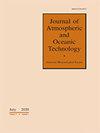从实际快速扫描雷达数据的垂直涡度方程约束双多普勒分析中评估垂直速度反演
IF 1.9
4区 地球科学
Q2 ENGINEERING, OCEAN
引用次数: 1
摘要
从双多普勒分析(DDA)中精确获取垂直速度是雷达气象学的一个长期难题。典型的雷达扫描策略很难观察到运动的垂直分量,导致垂直速度估计的不确定性很大。在DDA中,除了质量守恒约束外,还使用垂直涡度方程约束,在提高垂直速度检索方面显示出希望。然而,观测系统模拟实验(OSSEs)表明,由于垂直涡度约束中的涡度趋势项,该技术需要快速雷达体扫描才能实现改进。在这里,垂直涡度约束DDA用真实的快速扫描雷达数据进行测试,以验证先前的OSSEs结果。通常,垂直涡度约束DDA比不使用约束的DDA产生更精确的垂直速度。当体扫描间隔时间大于30秒时,涡度趋势估计方法对垂向速度精度影响显著。通过对临时DDA风场进行平流校正来缩短涡度趋势计算的离散化间隔,提高了体扫描之间的垂直速度检索时间。这些dda的技能与那些使用更短时间间隔进行容积扫描的人相似。这些改进是由于使用平流校正技术提高了垂直涡度趋势的精度。实际雷达数据测试也表明,垂直涡度约束dda对雷达数据误差的容忍度更高。这些结果表明,垂直涡度约束快速扫描雷达DDA应优先进行运动学分析。本文章由计算机程序翻译,如有差异,请以英文原文为准。
Evaluating vertical velocity retrievals from vertical vorticity equation constrained dual-Doppler analysis of real, rapid-scan radar data
Accurate vertical velocity retrieval from dual-Doppler analysis (DDA) is a longstanding problem of radar meteorology. Typical radar scanning strategies poorly observe the vertical component of motion, leading to large uncertainty in vertical velocity estimates. Using a vertical vorticity equation constraint in addition to a mass conservation constraint in DDA has shown promise in improving vertical velocity retrievals. However, observation system simulation experiments (OSSEs) suggest this technique requires rapid radar volume scans to realize the improvements due to the vorticity tendency term in the vertical vorticity constraint. Here, the vertical vorticity constraint DDA is tested with real, rapid-scan radar data to validate prior OSSEs results. Generally, the vertical vorticity constraint DDA produced more accurate vertical velocities from DDAs than those that did not use the constraint. When the time between volume scans was greater than 30 seconds, the vertical velocity accuracy was significantly affected by the vorticity tendency estimation method. A technique that uses advection correction on provisional DDA wind fields to shorten the discretization interval for the vorticity tendency calculation improved the vertical velocity retrievals for longer times between volume scans. The skill of these DDAs was similar to those using a shorter time between volume scans. These improvements were due to increased accuracy of the vertical vorticity tendency using the advection correction technique. The real radar data tests also revealed that the vertical vorticity constraint DDAs are more forgiving to radar data errors. These results suggest that vertical vorticity constraint DDA with rapid-scan radars should be prioritized for kinematic analyses.
求助全文
通过发布文献求助,成功后即可免费获取论文全文。
去求助
来源期刊
CiteScore
4.50
自引率
9.10%
发文量
135
审稿时长
3 months
期刊介绍:
The Journal of Atmospheric and Oceanic Technology (JTECH) publishes research describing instrumentation and methods used in atmospheric and oceanic research, including remote sensing instruments; measurements, validation, and data analysis techniques from satellites, aircraft, balloons, and surface-based platforms; in situ instruments, measurements, and methods for data acquisition, analysis, and interpretation and assimilation in numerical models; and information systems and algorithms.

 求助内容:
求助内容: 应助结果提醒方式:
应助结果提醒方式:


